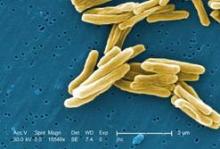The risk of multidrug-resistant tuberculosis appears similar in children and treatment-naive adults, according to a study published online ahead of World Tuberculosis Day, which is March 24.
This study provides the first global and regional estimates of the incidence of drug-resistant disease in children.
Researchers led by Helen E. Jenkins, Ph.D., of Brigham and Women’s Hospital, Boston, calculated the incidence of tuberculosis in children and conducted a systematic review to estimate the risk of multidrug-resistant disease. They concluded that nearly 1 million children developed tuberculosis in 2010 – a figure substantially higher than the 2011 World Health Organization estimates. Of those, nearly 32,000 had multidrug-resistant disease.
The highest concentrations of pediatric tuberculosis and drug-resistant disease were in Southeast Asia, according to Dr. Jenkins and her associates (Lancet 2014 March 24 [doi: 10.1016/S0140-6736(14)60195-1]).
In an accompanying editorial, Dr. Ben J. Marais of the Marie Bashir Institute for Infectious Diseases and Biosecurity, University of Sydney, Australia, called the study the "most rigorous effort to date to provide contextualized estimates of both tuberculosis and multidrug-resistant tuberculosis incidence in children," and said it was likely to provide a benchmark for future studies in the area.
"Given that treatment outcomes for children with multidrug-resistant tuberculosis are excellent (clinical cure rates in excess of 80%), every effort should be made to reduce the massive case-detection gap and address the vast unmet need for diagnosis and treatment," he said (Lancet 2014 March 24 [doi: 10.1016/S0140-6736(14)60489-X]).
The authors and Dr. Marais declared that they had no competing interests. Funding for the study was provided by awards from the U.S. National Institute of General Medical Sciences and the National Institute of Allergy and Infectious Diseases, as well as various fellowships.


